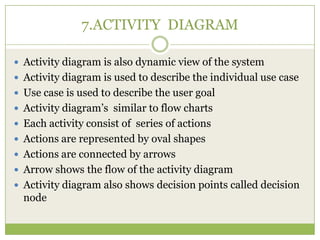Unified Modelling Language
- 1. UML (Unified Modeling Language) Visualizing Specifying Constructing Documenting
- 2. Why do we model? Model is a simplification of reality. Provides blueprint of sys. May be structural or behavioural. Modeling-For better understanding of sys.that are developing Achieve 4 aims: 1. Helps to visualize sys. 2. Permits to specify struc or behav of sys. 3. Provide templates to guide in constructn sys. 4. Document decisions made.
- 3. Applications of UML Enterprise infmn sys. Banking and financial services. Telecommunications Transportation Defense/aerospace Medical electronics Scientific Distributed Web-based services
- 4. Building blocks of UML Things II. Relationships III. Diagrams Things in the UML: Four kinds: 1. Structural things 2. Behavioral things 3. Grouping things 4. Annotational things I.
- 5. Structural things Seven kinds: 1. Class 2. Interface 3. Collaboration 4. Use case 5. Active class 6. Component 7. Node
- 6. Structural things.. Construct Description class a description of a set of objects that share the same attributes, operations, methods, relationships and semantics. Collection of operation that specify service of a class or component.Complete behavr.of class/compnt.describes externally visible behavr of an element. Defines interactn and is a society of roles and other elements that work together to provide some cooperative behavr that’s bigger than sum of all elements. Have structural and behavioral dimensns interface collaboration Syntax ispelling
- 7. Structural things.. Construct Description use case Description of set of sequence of action that a sys performs. Used to structure the behavioral things in a model A class whose objts own one or more processes and therefore intiate cntrl actvty. Physical and replaceable part of a system that conform to and provides realizn of a set of interfaces a run-time physical object that represents a computational resource. active class component node Syntax Place order
- 8. 2.Behavioral Things Construct 1.Interaction 2.State machine Description A set of msgs exchangd among a set of objts vd in a particular context to accomplish a specific purpose.Involves no.of other elements including msgs,action sequences and links Specifies sequences of state of an objt goes thru during its lifetime response to those events.Involves no.of other elements includn states,transtn,evnts syntax display Waiting
- 9. 3.Grouping things Organizational parts of UML models. Models decomposed in to boxes Primary kind is Package Packages are basic grouping things with which UML model can be organized. Business rules
- 10. 4.Annotational things Explanatory parts of UML models. Comments to describe illuminate or remark about any element in a model. Primary kind of annotation thing called note. Note is simply a symbol for rendering constraints and comments attached to an element or collection of elements.
- 11. II. Relationships in the UML Construct Description a relationship between two modeling elements, in which a change to one modeling element (the independent element) will affect the other modeling element (the dependent element). a relationship between two or more association classifiers that involves connections among their instances. Aggregation is a spl kind of assocn represntn structural reltnshp b/w whole and its parts generalization Objts of specialized element(child) are substitutable for objts of the generalized element(parent). a relationship between a specification realization and its implementation. dependency Syntax
- 12. III. Diagrams in the UML 1.Class diagram 2.Object diagram 3.Use case diagram 4.Sequence diagram 5.Collaboration diagram 6.Statechart diagram 7.Activity diagram 8.Component diagram 9.Deployment diagram
- 13. 1.CLASS DIAGRAM It depicts the static view of a model It is the basic building block of the object oriented system It illustrate the relation ship between classes in the system Class diagram consist of: Class diagram It consist of rectangle with three compartments Class name is added in this this compartment (teacher) Class attribute is added in this department (name ) Class methods are placed in this compartments (teach)
- 14. 2.OBJECT DIAGRAM • Object diagrams emphasize the relationship between instances of classes at some point in time Object is shown by a rectangular with classifier name in the center f rectangular and under line.
- 15. 3.USE CASE DIAGRAM This diagram consist of: Actor It is represented by a human, either the actor is a human Or and external system. Actor is role Use case It is represented by an oval shape with title in it
- 16. 4.SEQUENCE DIAGRAM Sequence diagrams provide a graphical representation of object interactions over time The diagrams show the flow of messages from one object to another, and as such correspond to the methods and events supported by a class/object.
- 17. 5.COLLABORATION DIAGRAM Type of an interaction diagram emphasizes structural organization of objt that send and receive msgs Collaborates the static and dynamic relationship Each message in a collaboration diagram has a sequence number. •
- 18. 6.STATECHART DIAGRAM A statechart diagram shows the possible states of the object and the transitions that cause a change in state. States are rounded rectangles. Transitions are arrows from one state to another. Events or conditions that trigger transitions are written beside the arrows.
- 19. 7.ACTIVITY DIAGRAM Activity diagram is also dynamic view of the system Activity diagram is used to describe the individual use case Use case is used to describe the user goal Activity diagram’s similar to flow charts Each activity consist of series of actions Actions are represented by oval shapes Actions are connected by arrows Arrow shows the flow of the activity diagram Activity diagram also shows decision points called decision node
- 20. ACTIVITY DIAGRAM.. Portion line Starting point Action Decision node Actions Endpoint
- 21. 8.COMPONENT DIAGRAM • Shows the organizations and dependencies among software components. Shows system in terms of modules.
- 22. 9.DEPLOYMENT DIAGRAM Shows the configuration of run-time processing elements and the software components, processes and objects that live on them. Deployment diagrams may be used to show which components may run on which nodes.





















